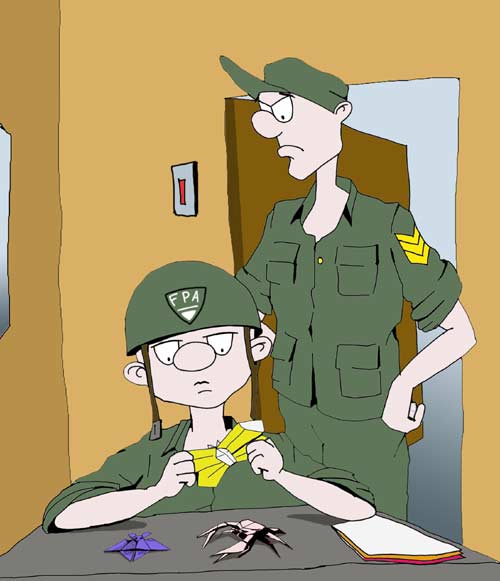Part I. Intro to Harmonic Patterns


Pipruit: And why are they so “special”?
Commander in Pips: Although they are best combined with other tools, but they are most self-sufficient among all the others. In other words – they could be used independently and you may trade purely based on these patterns. But again – their combination with other tools could give better results still.
Pipruit: And what’s the general idea of these patterns?
Commander in Pips: All these patterns are based on Fibonacci ratios and each pattern is a combination of retracement and extension. That’s why we have to study them after the Fibonacci chapter. Here is what we will talk about:
1. Gartley’s AB=CD pattern;
2. Gartley’s “222” pattern;
3. Gartley’s Butterfly pattern;
4. Crab and Bat patterns;
5. And, finally, the 3-Drive pattern
Pipruit: Oh, I still can’t remember all details about triangles and candlesticks, and here again – a lot of different patterns. How I could grasp all this stuff?
Commander in Pips: Don’t worry. All of these patterns are based at the same principles, and once you grasp, say, butterfly, there will be no problem to understand Crab and the others as well. So, Butterfly, Crab and Bat are almost the same.
For each pattern we will specify the structure and some binding rules that never could be broken, otherwise the pattern will be treated as failed. Then we will specify some advanced moments – how to manage your position if you trade these patterns, and rules that will help you to understand the depth of retracement and target estimations.
One of the specific moments for these patterns is that we should not anticipate them for our safety and that it is better enter when you’ll see fully completed pattern. They are mostly reversal patterns. So, let’s get to work…
Don’t worry. All of these patterns are based at the same principles, and once you grasp, say, butterfly, there will be no problem to understand Crab and the others as well. So, Butterfly, Crab and Bat are almost the same.
Comments
M
mmtto
12 years ago,
Registered user
Look forward to this new chapter on Harmonic Patterns. By the way Sive, could you write something on trading multiple time frames after this chapter?
Thanks.
Thanks.
Sive Morten
12 years ago,
Registered user
> Look forward to this new chapter on Harmonic Patterns. By the way Sive, could you write something on trading multiple time frames after this chapter?
Thanks.
Hi Mmtto
Yes, there will be the chapter dedicated to multiple time frames, but not next, it will come a bit later...
Thanks.
Hi Mmtto
Yes, there will be the chapter dedicated to multiple time frames, but not next, it will come a bit later...
M
mmtto
12 years ago,
Registered user
Noted. Thanks a lot.
Hamza Samiullah
6 years ago,
Registered user
Excellent starting
O
One-fm
5 years ago,
Registered user
I have waited so long for this.
K
kangara
5 years ago,
Registered user
Nice work
Table of Contents
- Introduction
- FOREX - What is it ?
- Why FOREX?
- The structure of the FOREX market
- Trading sessions
- Where does the money come from in FOREX?
- Different types of market analysis
- Chart types
- Support and Resistance
-
Candlesticks – what are they?
- Part I. Candlesticks – what are they?
- Part II. How to interpret different candlesticks?
- Part III. Simple but fundamental and important patterns
- Part IV. Single Candlestick Patterns
- Part V. Double Deuce – dual candlestick patterns
- Part VI. Triple candlestick patterns
- Part VII - Summary: Japanese Candlesticks and Patterns Sheet
-
Mysterious Fibonacci
- Part I. Mysterious Fibonacci
- Part II. Fibonacci Retracement
- Part III. Advanced talks on Fibonacci Retracement
- Part IV. Sometimes Mr. Fibonacci could fail...really
- Part V. Combination of Fibonacci levels with other lines
- Part VI. Combination of Fibonacci levels with candle patterns
- Part VII. Fibonacci Extensions
- Part VIII. Advanced view on Fibonacci Extensions
- Part IX. Using Fibonacci for placing orders
- Part X. Fibonacci Summary
-
Introduction to Moving Averages
- Part I. Introduction to Moving Averages
- Part II. Simple Moving Average
- Part III. Exponential Moving Average
- Part IV. Which one is better – EMA or SMA?
- Part V. Using Moving Averages. Displaced MA
- Part VI. Trading moving averages crossover
- Part VII. Dynamic support and resistance
- Part VIII. Summary of Moving Averages
-
Bollinger Bands
- Part I. Bollinger Bands
- Part II. Moving Average Convergence Divergence - MACD
- Part III. Parabolic SAR - Stop And Reversal
- Part IV. Stochastic
- Part V. Relative Strength Index
- Part VI. Detrended Oscillator and Momentum Indicator
- Part VII. Average Directional Move Index – ADX
- Part VIII. Indicators: Tightening All Together
- Leading and Lagging Indicators
- Basic chart patterns
- Pivot points – description and calculation
- Elliot Wave Theory
- Intro to Harmonic Patterns
- Divergence Intro
- Harmonic Approach to Recognizing a Trend Day
- Intro to Breakouts and Fakeouts
- Again about Fundamental Analysis
- Cross Pair – What the Beast is That?
- Multiple Time Frame Intro
- Market Sentiment and COT report
- Dealing with the News
- Let's Start with Carry
- Let’s Meet with Dollar Index
- Intermarket Analysis - Commodities
- Trading Plan Framework – Common Thoughts
- A Bit More About Personality
- Mechanical Trading System Intro
- Tracking Your Performance
- Risk Management Framework
- A Bit More About Leverage
- Why Do We Need Stop-Loss Orders?
- Scaling of Position
- Intramarket Correlations
- Some Talk About Brokers
- Forex Scam - Money Managers
- Graduation!